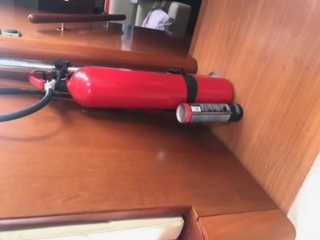Fire in boats

|
I’ve put this here as notes to self and potential new crew. I should also mention the special relationship between Mojo and the emergency services when out at sea; we don’t bother calling them and they can’t reach us anyway. Haha. Rescue
helicopter range is only around 300miles offshore.
Fire risk is highest in a marina - from other boats. Transfer can be rapid. Perhaps consider the potential risk from neighbouring boats, especially those upwind.
Best is always be ready to either fight a fire and/or (if it’s got going) leave with your boat ASAP. Extinguishers unclipped for option 1, or slasher knife for tight mooring lines, keys in ignition and motors ready to start 24/7 as far as possible.
Inside, main risk is the gas hob cooking. Galley floor towels keep floors dry to walk on, and are good to pick up and suffocate cooking fires. Galley blanket shouldn’t be in the galley obviously, duh.
Smoke alarms should trigger easily when (say) using a nearby toaster.
Big 10-20kg CO2 canister and a faceguard can help fight a fire and there may be no option if there’s others to rescue. Small powder extinguishers only pass the boatbuilding regulations, and are single use so they can’t be tested. Like life jackets and liferafts which is why it’s best to have more than one of everything.
At sea, risk of fire means liferafts should be kinda ready in seconds not minutes, floating (80% full) water bottles roped together, grab bags etc. Passport, wallet, Go.
I don’t leave a lit gas hob unattended - turn off first as my 10-second boat fixes usually take about half an hour minimum.
The dinghy runs on petrol aka gasoline. So I suppose it’s best have that downwind if attached (i.e. on stern davits not foredeck) and gas tank out of direct sunlight.
Yeah it’s morbid stuff. But not much mentioned in sail training, if at all. Bad for business I suppose.
|
